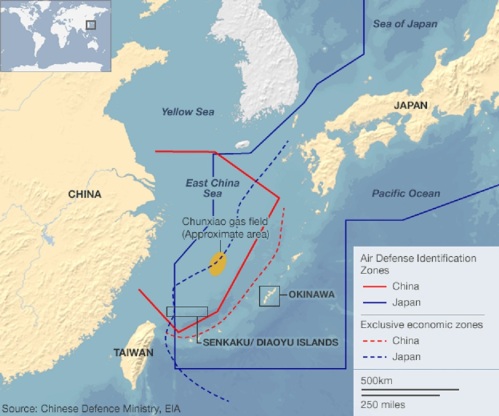China’s territorial claims over the South China Sea were dealt a blow today when in a landmark ruling, an international tribunal in The Hague, Netherlands, rejected Beijing’s claims.
Six regional governments have overlapping territorial claims in the South China Sea, waters that are rich in fishing stocks and potential energy resources and where an estimated $5 trillion in global trade passes each year.
The AP reports that China claims vast areas of the South China Sea have been Chinese territory since ancient times and demarcated its modern claims with the so-called nine-dash line, a map that was submitted under the U.N. treaty.
In 2013, under a U.N. treaty governing the seas, the Philippines had asked The Hague for arbitration on a number of issues it had with treaty co-signee China, on the grounds that China’s claims infringe upon the Philippines’ 200-mile exclusive economic zone.
On July 12, 2016, the five-member panel from the Permanent Court of Arbitration in The Hague, Netherlands, unanimously ruled against China. The tribunal also found the following:
- Any historical resource rights China may have had in the South China Sea are nulled if they are incompatible with exclusive economic zones established under the U.N. treaty signed by both China and the Philippines.
- China had violated its obligations to refrain from aggravating the regional dispute while the settlement process was ongoing.
- By building up artificial islands in the Sea, China had caused “permanent irreparable harm” to the coral reef ecosystem.
- China had violated the Philippines’ maritime rights by:
- Disrupting Philippine’ oil exploration at Reed Bank.
- Disrupting fishing by Philippine vessels within the country’s exclusive economic zone, and failing to prevent Chinese fishermen from fishing within the Philippines’ exclusive economic zone at Mischief Reef and Second Thomas Shoal.
China, which boycotted the entire proceedings, immediately rejected the ruling as a “farce” and “a US-led conspiracy,” and declared it does not accept the panel’s jurisdiction. Beijing regards bilateral talks with the other claimants as the only way to address the South China Sea disputes.
China’s foreign ministry declared that “the award is null and void and has no binding force. China neither accepts nor recognizes it,” and that “China’s territorial sovereignty and maritime rights and interests in the South China Sea shall under no circumstances be affected by those awards.” The ministry repeated China’s often-expressed stance that the Philippines’ move to initiate arbitration without China’s consent was in “bad faith” and in violation of international law.
The editor-in-chief of China.org.cn writes:
The U.S. actions near China, particularly those on the South China Sea issues, are part of its Asia-Pacific Rebalance strategies. Its intentions are no more than containing China to preserve its interests in the Asia-Pacific region and its global hegemony.
The U.S. motives are apparent to the world, especially to the Chinese people. The current China is nothing like the country it was one hundred years ago. Any act that tries to violate China’s territorial sovereignty will fail.
Although the tribunal has no power of enforcement, nor can its findings reverse China’s actions, nevertheless the ruling constitutes a rebuke with the force of the international community’s opinion. A professor of Asian political economy said the ruling could be a “transformative moment” in the region. Speaking outside the Peace Palace in The Hague, Leiden University professor Jonathan London said the decision will “give countries with a common interest in international norms something to point to and to rally around.” He said they can say to China: “Look, here are the results of an international organization that has found that your claims have zero historical basis.”
The tribunal’s decision also gives heart to small countries in Asia that have helplessly chafed at China’s expansionism, backed by its military and economic power.
In Manila, dozens of rallying Filipinos jumped for joy, wept, embraced each other and waved Philippine flags after news of their victory. One held up a poster that said: “Philippine sovereignty, non-negotiable.”
Philippine Foreign Secretary Perfecto Yasay hailed the ruling as a “milestone decision” and “an important contribution to ongoing efforts in addressing disputes in the South China Sea,” and called on “all those concerned to exercise restraint and sobriety.” For his part, Philippines’ former Foreign Secretary Albert del Rosario, who helped oversee the filing of the case at Hague, said the ruling underscored “our collective belief that right is might and that international law is the great equalizer among states.” He urged that the ruling be accepted by all relevant countries — without exception — in order to maintain international order “so that we can work together on how remaining issues can be peacefully resolved.”
Vietnam’s government also welcomed the ruling. Just today, Vietnam accused Chinese vessels of sinking a Vietnamese fishing boat in disputed waters. Nguyen Thanh Hung, a local fisheries executive in the central province of Quang Ngai, said two Chinese vessels chased and sank the Vietnamese boat around midday Saturday as it was fishing near the Paracel islands. The five fishermen were rescued by another trawler around seven hours later.
Japan’s Foreign Minister Fumio Kishida said the tribunal’s decision is “final and legally binding” and that the two sides should comply with it. He said in a statement that “Japan strongly expects that the parties’ compliance with this award will eventually lead to the peaceful settlement of disputes in the South China Sea.”
The disputes have also increased friction between China and the United States. Washington has ramped up U.S. military presence in the region as China expands its navy’s reach farther offshore.
At a news conference in Afghanistan where he was meeting with U.S. commanders, Defense Secretary Ash Carter said the ruling is an opportunity for everyone in the region to act in a sensible way in accordance with the rule of law in order to settle disputes. The United States has not taken sides in the South China Sea disputes but has worked to ensure freedom of navigation and overflight in the region.
See also:













